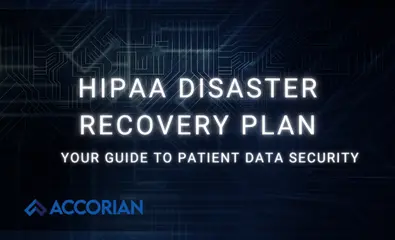In the dynamic cybersecurity landscape, 2023 statistics reveal an alarming 53% of incidents targeted healthcare providers, emphasizing the need to protect sensitive patient data under the Health Insurance Portability and Accountability Act (HIPAA) 1996. HIPAA, a cybersecurity cornerstone, mandates compliance and safeguards for Protected Health Information (PHI). Beyond data protection, it underscores HIPAA disaster recovery plans, compelling organizations to establish strategies for mitigating risks and ensuring patient data availability, integrity, and confidentiality.
What is the HIPAA Disaster Recovery Plan?
A disaster is an unforeseen event beyond organizational control that harms IT infrastructure and compromises sensitive PHI data. To safeguard against the threat, a HIPAA disaster recovery plan plays a crucial role. This plan delineates an IT-focused strategy to restore system operability, be it the entire infrastructure, specific computer facilities, or applications, at an alternate site post an emergency.
The plan includes policies and procedures to be executed in the event of a disaster, assigning responsibilities to staff for a swift and efficient response and recovery. Furthermore, the HIPAA Disaster Recovery Plan is a comprehensive strategy focused on safeguarding and recovering ePHI in the face of diverse emergencies, ranging from natural disasters to cyberattacks and human errors.
Steps to Create a HIPAA Disaster Recovery Plan
The BIA process for your organization includes:
- Identifying the various types and sizes of data within your management purview
- Recognizing where your data is stored and acknowledging the systems critical to your day-to-day operations
- Estimating the maximum resources and time required to recover each data type
2. Perform a Risk Assessment
Establish a robust risk assessment framework that integrates continuous monitoring and analysis. A vital element of this framework involves developing an extensive risk register and strategically prioritizing potential threats based on their likelihood and impact on the organization.
Additionally, simulate hypothetical disaster scenarios to assess their potential consequences:
- Cybersecurity Threats: Unauthorized intrusions, such as malware, ransomware, or hacking attempts, pose a significant risk by disrupting systems and compromising critical data.
- Severe Environmental Incidents: Events like hurricanes, floods, tornadoes, and adverse weather conditions can lead to extended power outages, impacting the seamless functioning of operations.
- IT Downtime: Situations involving reduced or non-existent IT availability due to technical malfunctions, software glitches, hardware failures, or unforeseen circumstances can immobilize operations.
- Establish a dedicated team for disaster recovery, assigning specific roles with a keen emphasis on a profound understanding of the pivotal role of HIPAA compliance in the recovery process.
- Implement regular exercises to ensure the team is adept at handling diverse scenarios and enabling a swift response in the face of cybersecurity challenges.
- Maintain an up-to-date contact list and communication strategy, facilitating prompt action when required. This ensures a rapid and coordinated response to cybersecurity incidents.
- Cyber Communication Protocols: Clearly outline reporting procedures for disasters, specifying the individuals to be notified and delineating each employee’s role in the aftermath.
- Inventory of Cyber Assets: Develop a comprehensive list of essential assets, including computers, tablets, scanners, printers, and phones. This inventory streamlines damage assessment and accelerates insurance claims, facilitating the prompt restoration of operations.
- Cyber Asset Protection: Integrate procedures for safeguarding equipment against potential damage, incorporating various protective strategies.
- Data Restoration Priority: Establish a hierarchical order for data restoration, prioritizing legally mandated data (e.g., ePHI), followed by illness records and data crucial for maintaining minimal service levels.
Create a Disaster Recovery Plan with Accorian
Accorian, founded by leaders in technology and cybersecurity, is committed to eliminating the compromise between technology necessities and organizational budgets. Our comprehensive technology services and wealth of experience assist clients in adhering to the HIPAA privacy rule.
We go beyond mere compliance box-checking. Our team collaborates with you to create HIPAA policies and procedures, develop awareness training, and conduct security risk assessments without disrupting your current business procedures. Whether you require assistance in policy creation or comprehensive security assessments, Accorian is your dedicated partner in achieving and sustaining HIPAA compliance.




